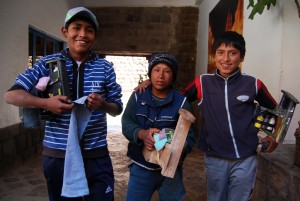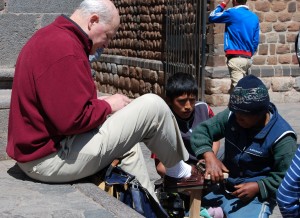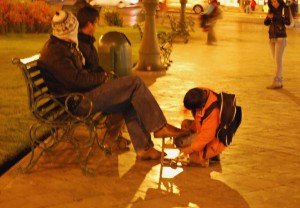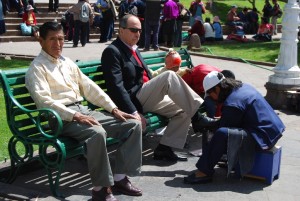Shoeshine Boys Win Over Tourists in Cuzco

“Shoe shine, Mister?” “Hey friend, shine your shoes?” These are questions thrown at tourists daily in the streets of Cuzco. Spoken mostly in English, they are phrases the shoe shine boys who walk through the streets near the Plaza de Armas use to reel in tourists. But it is not only their words that capture, their smiles and insistence win people over.
It is not known with any precision how many shoeshine boys there are. Every day some withdraw and others begin. But there are always shoeshine boys in the tourist area of Cuzco.
The majority of shoe shine boys are between the ages of five and fifteen. There are others, who are older, that have established themselves in a shoe shine stand, often by the side of a newspaper or magazine kiosk.
The shoeshine boys are known collectively by the name of “canillas” or the more affectionate diminutive “canillitas”. Besides shining shoes, these children who labor in the street also work as cobradores(fare collectors) in public transportation and as sellers of handicrafts, candies, and other products destined for tourists. For many this is only an occasional job. For others it is the only way they can survive. One can see both aspects in the lives of these young people.

The boys move around in small groups for support, to stay alert, and to feel confident. They also cling together to protect themselves from abuse doled out by older boys.

These children grow up in the cold and lonely space of the street and they learn the lessons it teaches.
Edmundo, Jonathan, and Fernando are three boys who daily work Cuzco’s streets to shine shoes. They are twelve, thirteen, and fourteen years old respectively, but they have become friends in the street. While the last two are from the city of Cuzco Edmundo is from the area of Paucartambo at some distance from the city.

They all study in the Garcilaso public school and are in the first year of secondary school. They say they earn some 20 S/ daily, about $7.50 US. Though it may not sound like much, those are not bad wages in a world where many make less than two dollars a day, even though from it they must deduct the cost of their polish.
Shoeshines cost one new sol for local people while shoeshine boys leave the fee up to the good will of tourists who then have to figure out, given their own background, how much they think the children and their work are worth.
Edmundo, Fernando, and Jonathan began working as shoe shine boys about two years ago. They designed their own shoe shine boxes and had to come up with the money to have them made and buy the polish, brushes, cloth, and such that they needed.
They must always be on the look out for police raids, since they will often detain the boys and confiscate their boxes. The police have become, in these days, their worst enemies. For some reason, it has been decided the police should try to eradicate this job which for many children is the only way they can survive with dignity.

Many times the boys do not escape from the raids. When grabbed by the police, they are taken to La Familia (a juvenile facility run by the police that is like a kind of hospice for these children.) If their parents come for them, then they are released. But if they do not, then they pass to other state institutions.
The boys generally work in the monumental core of the city where their phrases resound.
”Shoe shine mister. It is possible.” “Where are you from?” “United States, capital Washington, president Barak Obama, money the dollar.”
Nevertheless, fear is always on the horizon. If not the police, the shoeshine boys have to look out for older boys, who also work in the streets and may interrupt their work, drive them away, beat them up, or worse.
The children generally do not work all day in the streets; they come in during the hours they are not studying. This means some kids work mornings, some afternoons, and some evenings. A a result the population of boys in the street is constantly changing.
“What is your name?” “Remember me?” “Yesterday you promised.”

The boys have to convince a wary group of tourists who may or may not think their shoes need shining to let them work and to pay them well. They also have to compete with other shoeshine boys. However, the competition is seldom based on price, since the boys do not charge a fixed price for tourists. Instead it is based on charm and wile. It is an attempt to connect, often personally, with the strangers from all over the world who daily throng the streets of Cuzco.
As a result, they boys are quite skilled in learning English and other languages. They know the capitals of relevant countries, their political leaders, and their currency as well as the colors of their flag. They become skilled in identifying the national origin of tourists in order to know the language in which to address them. Sometimes it is their physical look and sometimes their accent that lets the boys know where the tourists come from. In any case the boys learn even about popular figures such as major sports teams and heroes, as well as entertainers in order to break the ice with the tourists.
They also have to quickly analyze the shoes worn by the tourists in order to know which services to offer. Even canvas shoes and sandals will have something that the boys can offer to do to make them look better.
“Clean shoes, Mister (friend, brother).” “Where are you from?”
While some of these boys are from the city’s poorer families, others are from the countryside where they have grown up working in the fields. They boys tell, though, of “waking up”, now, with people from all over the world. Every day they meet many gringos with whom they can play, converse, and pass time. Every day the boys make new friends from all over the world in the main square, the Plaza de Armas.

Like the shoe shine boys, the boys who sell post cars or pictures, also try to charm the tourists. Often they go out at night. They may work the discos. There they take advantage of the fact that people have drunk and their inhibitions are lowered. They persuade them to buy post cards. Some tourists give in because they feel sorry for the boys, other because they can’t seem to shake them, and others because they are very skilled in convincing from their many early mornings working in the streets. It is the same with the shoeshine boys.
The boys find some sort of equilibrium that lets them seduce the visitors to the city. For the tourist this interaction, whether charming and fun or an annoyance, is part of the experience of being in Cuzco. For a surprising number it is moving. Many tourists seem to fall in love with these friendly, sincere, and humble kids. In any case no tourist will manage to avoid them. They will be in their path and wait for them outside their hotels and restaurants in order to charm them. This, after all, is part of the life and culture of Cuzco.




